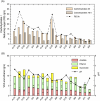Revalorisation of brewer's spent grain for biotechnological production of hydrogen with Escherichia coli
- PMID: 39654829
- PMCID: PMC11625585
- DOI: 10.3389/fbioe.2024.1473704
Revalorisation of brewer's spent grain for biotechnological production of hydrogen with Escherichia coli
Abstract
Introduction: Agro-industrial wastes are generated in huge amounts triggering damages to the environment and human health. Therefore, there is an urgent necessity for its revalorisation into high-value compounds, including biofuels. One such wastes is the brewer's spent grain (BSG), a by-product of the beer industry, which is produced in vast quantities worldwide. The rich-fibre and protein content of BSG makes this waste a valuable resource for biotechnological applications, although the main challenge of this approach is to make the carbohydrates and proteins available for bacterial metabolisation into high-value products. This work aims to optimise a thermal-hydrolysis process to revalorise BSG by bacterial conversion into hydrogen (H2), as a clean energy that can replace fossil fuels.
Methods: A 2k full factorial design method was employed hydrolysation of BSG and showed that temperature and acid concentration are significant factors that affect the extraction of reducing sugars (RS) and proteins. Subsequently, steepest ascent and central composite design (CCD) statistical methods were applied to determine the optimal conditions for hydrolysis.
Results: The optimised hydrolysis condition were 0.047 M H2SO4, 150°C, 30 min and 15% BSG, leading to the theoretical concentrations of 54.8 g RS/L and 20 g/L proteins. However, 5'-hydroxymethylfurfural (HMF) was generated in thermal-hydrolysis conditions at higher temperatures exceeding 132°C. Therefore, a screening of HBSGs fermentation using Escherichia coli was conducted in order to identify the most suitable conditions for maximizing H2, as well as the production of volatile fatty acids (succinate and acetate) and ethanol. Among the tested conditions, HBSG A17 (117°C, 20 min, and 0.1 M H2SO4) yielded the highest H2 production of 48 mmol/L in this work.
Conclusion: This study provides valuable insights into the optimisation of BSG pre-treatment for biotechnological applications, which may help in the selection of the most appropriate hydrolysis conditions based on the desired end product.
Keywords: Escherichia coli; biohydrogen; brewer’s spent grain; dark fermentation; design of experiment.
Copyright © 2024 Cabrera, Jáimez, Sánchez-Oneto, Bolivar and Valle.
Conflict of interest statement
The authors declare that the research was conducted in the absence of any commercial or financial relationships that could be construed as a potential conflict of interest.
Figures








Similar articles
-
Brewer's spent grain: a valuable feedstock for industrial applications.J Sci Food Agric. 2014 May;94(7):1264-75. doi: 10.1002/jsfa.6486. Epub 2014 Jan 24. J Sci Food Agric. 2014. PMID: 24254316 Review.
-
Valorization of Brewer's Spent Grain Using Biological Treatments and its Application in Feeds for European Seabass (Dicentrarchus labrax).Front Bioeng Biotechnol. 2022 May 3;10:732948. doi: 10.3389/fbioe.2022.732948. eCollection 2022. Front Bioeng Biotechnol. 2022. PMID: 35592554 Free PMC article.
-
Recent advances in microbial high-value utilization of brewer's spent grain.Bioresour Technol. 2024 Sep;408:131197. doi: 10.1016/j.biortech.2024.131197. Epub 2024 Aug 5. Bioresour Technol. 2024. PMID: 39097237 Review.
-
Current extraction techniques towards bioactive compounds from brewer's spent grain - A review.Crit Rev Food Sci Nutr. 2020;60(16):2730-2741. doi: 10.1080/10408398.2019.1655632. Epub 2019 Aug 21. Crit Rev Food Sci Nutr. 2020. PMID: 31433199 Review.
-
Production of single cell protein from brewer's spent grain through enzymatic saccharification and fermentation enhanced by ammoniation pretreatment.Bioresour Technol. 2024 Feb;394:130242. doi: 10.1016/j.biortech.2023.130242. Epub 2023 Dec 24. Bioresour Technol. 2024. PMID: 38145760
References
-
- Barth Haas group Report (2023-2024). Joh. Barth and Sohn Nürnberg. Available at: https://www.barthhaas.com/en/.
-
- Baruah J., Nath B. K., Sharma R., Kumar S., Deka R. C., Baruah D. C., et al. (2018). Recent trends in the pretreatment of lignocellulosic biomass for value-added products. Front. Energy Res. 6, 1–19. 10.3389/fenrg.2018.00141 - DOI
-
- Castilla-Archilla J., Papirio S., Lens P. N. L. (2021). Two step process for volatile fatty acid production from brewery spent grain: hydrolysis and direct acidogenic fermentation using anaerobic granular sludge. Process Biochem. 100, 272–283. 10.1016/j.procbio.2020.10.011 - DOI
-
- Corchado-Lopo C., Martínez-Avila O., Marti E., Llimós J., Busquets A. M, Kucera D. , et al. (2021). Brewer’s spent grain as a no-cost substrate for polyhydroxyalkanoates production: Assessment of pretreatment strategies and different bacterial strains. N. Biotechnol. 62, 60–67. 10.1016/j.nbt.2021.01.009 - DOI - PubMed
LinkOut - more resources
Full Text Sources
Miscellaneous

